Kanazawa is one of those cities that sneaks up on you. Before I moved to Japan and started working in the travel industry here, I pictured it as another garden city: nice for a side trip, but only if you have time in your itinerary. Turns out, I was wrong. Kanazawa is compact, walkable, and lets you slow down while still packing in top sights, excellent seafood, and genuine old-town neighborhoods just a short stroll apart. You don’t waste hours on transit like you do in Tokyo or Kyoto, and the city keeps a laid-back pace that’s easy to settle into, especially if you stick around for an evening or two. This Kanazawa guide covers when and how to visit, how much time you really need, itineraries, food worth planning for, the best areas to stay, tips for getting around, and a few day trips that actually fit without wearing you out. If you want a Japanese city that works on a human scale and feels welcoming from the start, Kanazawa is a great bet, no matter which season you land here.
Kanazawa in a Nutshell
If you’re short on time, here’s the article in a nutshell.
- Where to stay: Ōmi-chō to Korinbo/Katamachi is the best all-round base. The Station area is easiest for day trips and buses. Higashi Chaya or Kazue-machi gives quiet old-town mornings and evenings. Nagamachi is calm and close to downtown. Nights are mellow and many places close by 9 pm.
- Stays to consider: Yamanoo in Higashi Chaya for a classic splurge. Hotel Kanazawa Zoushi near Ōmi-chō for ryokan touches without the trek. Hotel Pacific Kanazawa for small and stylish near the castle. Hyatt Centric by the station for space and convenience. Dormy Inn for a bigger public bath. Machiya townhouses suit couples or families who want privacy.
- Getting around: Walk the central triangle (Kanazawa Station, Higashi Chaya, and Kenroku-en/Castle Park). Use the Kanazawa Loop Bus when legs get tired. Taxis help after dinner or in rain.
- When to go: Spring blossoms and mid November foliage are peak. Winter is quiet with top seafood. Early June has the Hyakumangoku Festival. Book early for blossom weeks, foliage, and festival dates.
- Time needed: Two full days is ideal. Add a third for museums or workshops. With four to five days, include Kaga Onsen or a Shirakawa-go day trip.
- Do not miss: Kenroku-en and the castle, the geisha districts, Nomura-ke in Nagamachi, Ōmi-chō Market, the 21st Century Museum or D. T. Suzuki Museum, and a gold leaf or Kutani session.
- Food: Plan seafood daily, try Kanazawa curry, oden in winter, and aim for earlier dinners.
Where to Stay in Kanazawa
Kanazawa is compact, which makes choosing where to stay more about the vibe you want than the distance to sights. Most places you’ll want to see sit in a triangle between Kanazawa Station, Higashi Chaya, and Kenroku-en/Castle Park. Here’s how the main areas feel:
- Kanazawa Station: Easiest for arrivals and departures, and the best bus connections. It’s a 20–25 minute walk or a short bus ride to the castle and garden. Plenty of business hotels.
- Ōmi-chō Market to Korinbo/Katamachi: My preferred base. Central, walkable to everything, and you’ll have food options at your door. Figure 10–15 minutes on foot to the castle and 15–20 to Kenroku-en.
- Higashi Chaya and Kazue-machi: Beautiful, atmospheric, quiet at night. Great if you want to wake up inside the old town. You’ll rely on short walks or buses for most sights.
- Nagamachi (samurai district): Calm and local. Handy for the samurai houses and close to downtown.
A quick expectation check: Kanazawa nights are mellow. Attractions mostly wrap up by late afternoon, and many restaurants close around 9 pm. If you like to stroll after dinner, staying near Korinbo/Katamachi or Ōmi-chō gives you the most options. For busy seasons (late March–early April for blossoms, mid-November for autumn colors, and the Hyakumangoku Festival in early June), I recommend booking early.
Ryokan and Traditional Stays
A traditional stay in Kanazawa is about slowing down: tatami rooms, futons, yukata robes, and meals you don’t have to think about. In the city center, many ryokan have small indoor baths rather than big onsen. If a full hot-spring experience is a priority, plan a night in nearby Kaga Onsen. In Kanazawa proper, aim for location, hospitality, and breakfast quality.
- Shoes off at the door, slippers inside.
- Futons laid out in the evening or self-serve in some guesthouses.
- Set meal times. If you book dinner, arrive by late afternoon.
- Staff often speak some English, but a few polite phrases go a long way.
Places I recommend, each with a different feel and budget:
- Yamanoo (Higashi Chaya): A classic splurge on a small hill overlooking the geisha district. It’s intimate, old-school, and puts you right next to evening walks through lantern-lit streets.
- Hotel Kanazawa Zoushi (near Ōmi-chō): A refined, ryokan-style boutique stay with the market a few minutes away. Great if you want traditional touches without being far from food and bus lines.
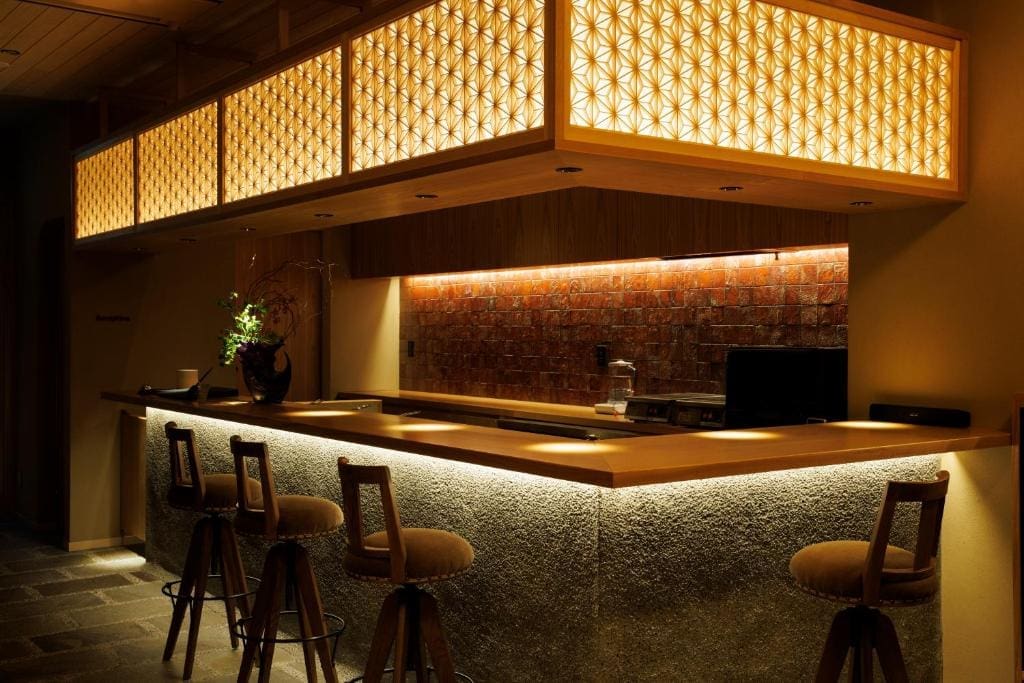
- Nakayasu Ryokan (downtown): Good value and a friendly base. Rooms were around ¥22,000/night for two people when I last checked.
- Machiya townhouses like Higashiyama Kageroi and Kazueya: Restored wooden homes in the historic districts, ideal for couples or families who want privacy. I like them for slower trips. One practical note: traditional homes can run cool in winter and have steep stairs. Confirm heating and bed setup if you’re not used to futons.
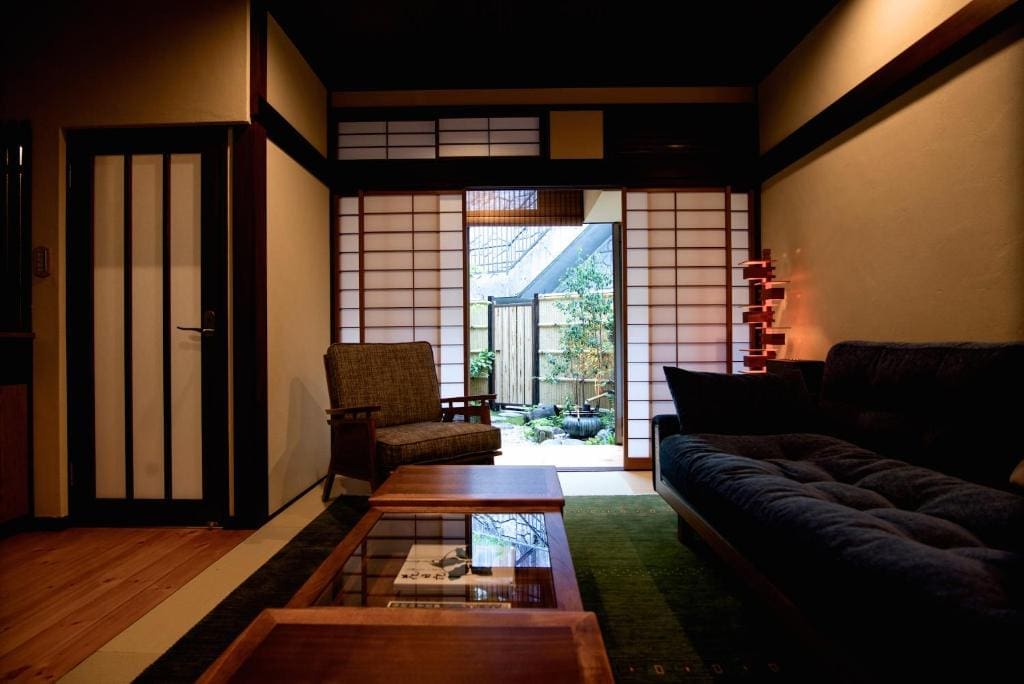
If you’re unsure about meals, I often suggest breakfast-included and dinner out. Kanazawa’s food scene is excellent and you won’t stress about making it back by a set time.
Tip: If your ryokan bath is small and you want a proper soak, consider an evening at a local sento (public bath) or choose a hotel with a large public bath for the next night.
Hotels and Modern Accommodation
Hotels in Kanazawa run the full range, from budget hostels to polished new builds by the station. The sweet spot for most travelers is a mid-range hotel near Ōmi-chō Market or Korinbo, which keeps you walkable to almost everything.
Typical costs to set expectations:
- Hostel beds: about ¥5,400–7,200
- Basic doubles: about ¥13,450–19,500
- Self-catering apartments: about ¥18,000–24,000
Standouts and dependable picks:
- Hotel Pacific Kanazawa (between Kazue-machi and Castle Park): Small, stylish, and in a quiet pocket that still feels central. I like it for couples or solo travelers who want character over chain.
- Hyatt Centric Kanazawa (by Kanazawa Station): Modern, comfortable, and convenient if you’re doing day trips or arriving late. Easy bus links and bigger rooms than most city-center options.
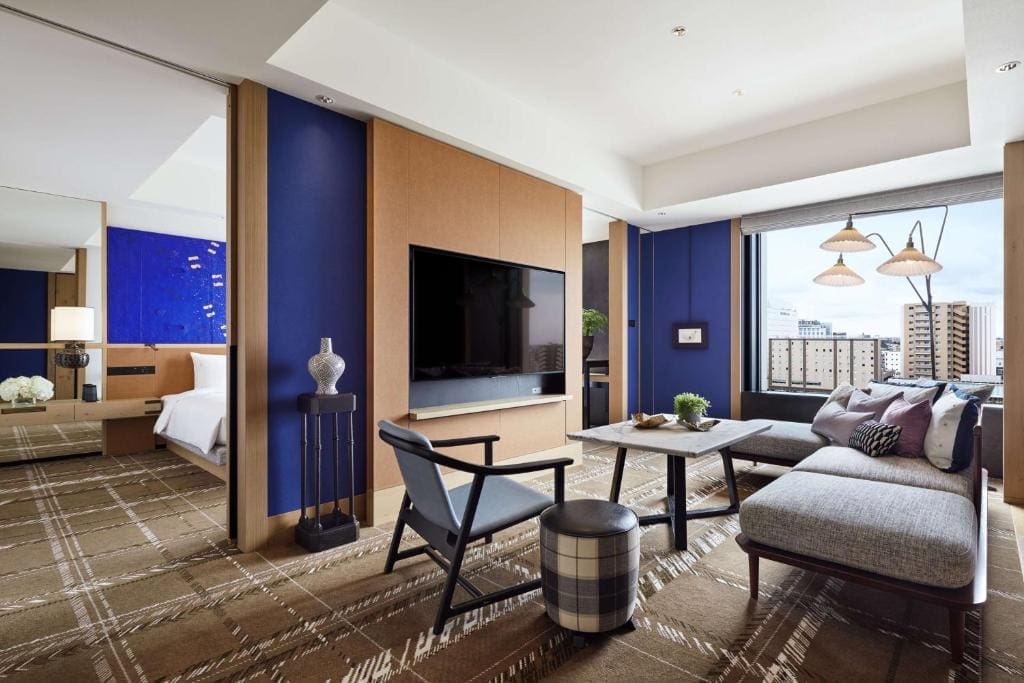
- Hotel Intergate Kanazawa (near Ōmi-chō): A solid base with a relaxing public bath and easy walks to the market, castle, and downtown. Good value in shoulder seasons.
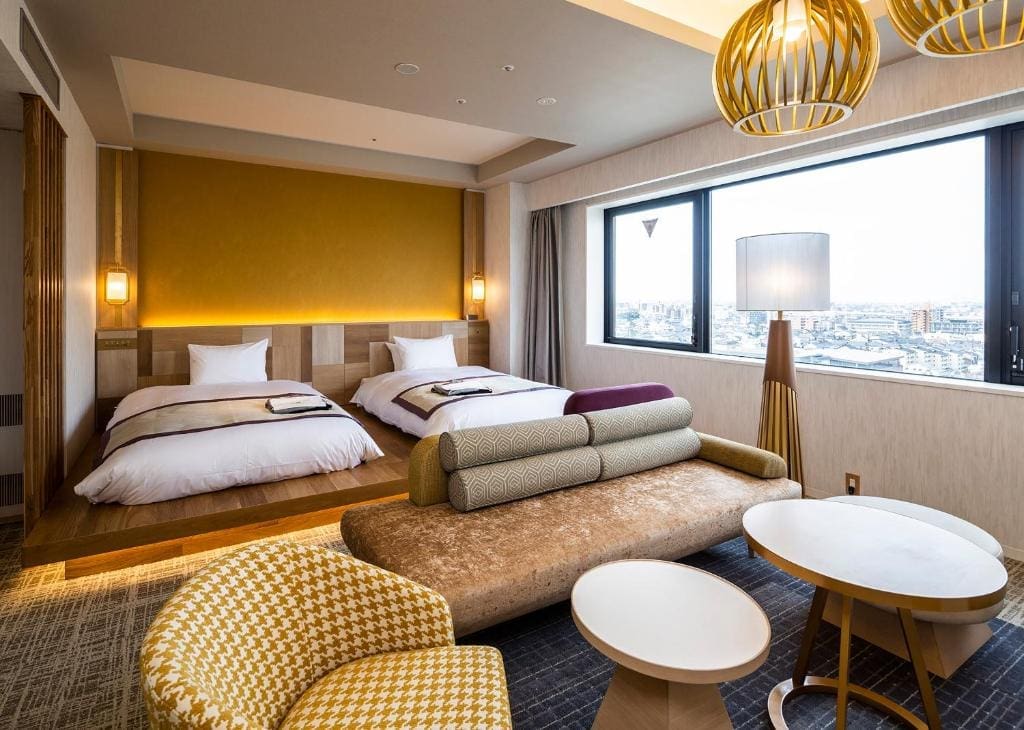
- Dormy Inn Kanazawa (Station area): Reliable mid-range with a larger public bath and the classic late-night noodle service. Ideal if you want onsen vibes without leaving the city.
- Apartment-style stays in Korinbo/Katamachi: Handy for families or longer trips. You’ll trade some traditional feel for laundry and a kitchenette.
Where to base yourself:
- For first-timers who want stress-free access to everything, I recommend the Ōmi-chō to Korinbo corridor. You’ll be able to walk to the castle, Kenroku-en, the samurai district, and buses for Higashi Chaya.
- If you’re planning multiple day trips, staying by the station makes sense. You’ll spend less time shuttling with luggage and more time on trains.
- If you want pure atmosphere, stay inside Higashi Chaya or Kazue-machi and accept a little transit time for the rest. It’s especially lovely in the early morning and at dusk.
Two final notes from my own trips:
- Kanazawa is calm at night, so hotel lounges and baths become part of the experience. I usually plan dinner on the earlier side and then a long soak.
- If you’re coming in peak leaf season or for the Hyakumangoku Festival in June, book as soon as your dates are firm. Good places disappear fast, especially the smaller ryokan and machiya.
Getting to and Around Kanazawa
Kanazawa is easy to reach and even easier to navigate. The Hokuriku Shinkansen connects it cleanly with Tokyo, and once you’re here the city’s core is flat and compact. Most sights sit in a neat triangle between Kanazawa Station, Kenroku-en and the geisha district Higashi Chaya, so you can walk a lot, then lean on the Loop Bus when your legs need a break. I usually recommend starting at Kanazawa Station, step outside to admire the Tsuzumi-mon Gate, then head straight into town on foot or by bus.
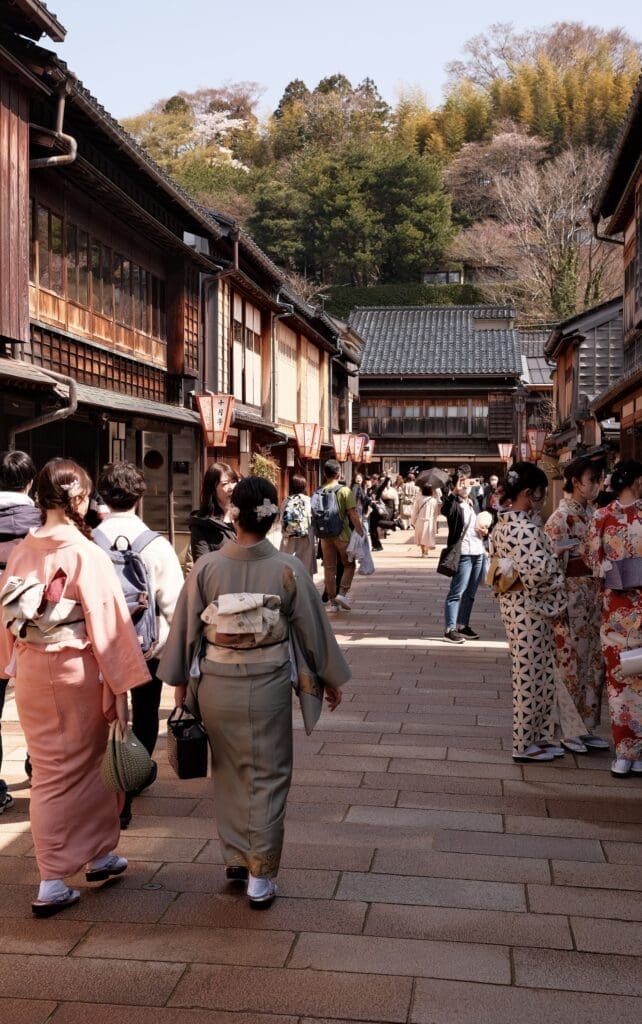
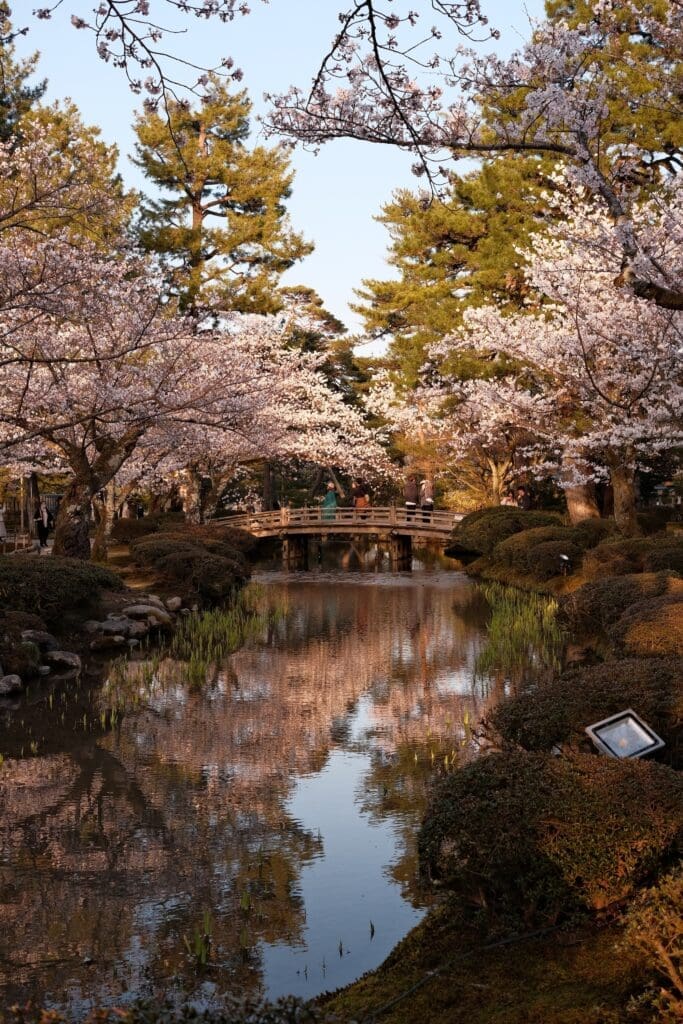
Arriving in Kanazawa
- From Tokyo: Take the Hokuriku Shinkansen from Tokyo or Ueno Station to Kanazawa. It’s about 2.5 to 3 hours, no transfers. If you’re carrying a suitcase, I recommend booking a reserved seat and stashing your bag in the space behind the last row or at your feet. Around holidays and cherry blossom season, these trains fill up.
➡️ Book Tokyo to Kanazawa shinkansen tickets on Klook - From Kyoto/Osaka: Ride the Limited Express Thunderbird to Tsuruga, then transfer to the Hokuriku Shinkansen for Kanazawa. The connection is straightforward and well signed. Door to door, plan on roughly 2.5 to 3 hours depending on departure and transfer. I like this route when I’m working my way between Kansai and Tokyo without backtracking.
- From Toyama and Fukui: The Hokuriku Shinkansen also links these cities directly to Kanazawa in a short hop. Handy for day trips in the region.
- By bus: Highway buses connect Kanazawa with Takayama, Shirakawa-go, Kyoto, and Osaka. If you’re visiting the gassho farmhouses in Shirakawa-go, the bus is the simplest link.
- By air: Komatsu Airport is the region’s main hub, about 35–40 minutes from Kanazawa Station by limousine bus. Flights connect to Tokyo, Sapporo, Fukuoka and some regional international hubs. If I’m flying in winter, I keep this option in mind in case the shinkansen faces weather delays.
Rail passes worth knowing: The Hokuriku Arch Pass can be great value if you’re traveling Tokyo → Kanazawa → Kansai. The Takayama-Hokuriku Area Tourist Pass is useful if you’re folding in Takayama and Shirakawa-go. If you already have a nationwide JR Pass, you’re covered for the JR portions above.

Arrival tips:
- Kanazawa Station is a destination in itself. The Tourist Information Center just inside has English maps, bus guidance and luggage delivery options. I recommend grabbing a city map here, it makes the first day simpler.
- Coin lockers and luggage delivery (takkyubin) are easy to use. If you arrive before hotel check-in, stash your bag and head out light.
- Weather can shift quickly on the Sea of Japan coast. In winter especially, trains can see short delays from wind, rain, or snow. The city works surprisingly well in snow thanks to its street sprinkler system, but waterproof shoes and a compact umbrella are worth packing.
Day trip or overnight?
You can dash in from Tokyo for the day if you take a very early train, but I don’t recommend day-tripping from Kansai. An overnight makes Kanazawa feel like a real stop instead of a blur, and you’ll get quiet evenings in the geisha districts that day-trippers miss.
Public Transport and Getting Around Town
Walking
Kanazawa’s center is pleasantly walkable. As a rough guide: Omicho Market to Kenroku-en is about 15 minutes, Kenroku-en to Higashi Chaya about 15 minutes, and Kenroku-en to Nagamachi samurai district about 20 minutes. I like planning days so each walk connects two or three sights with a snack stop in between.
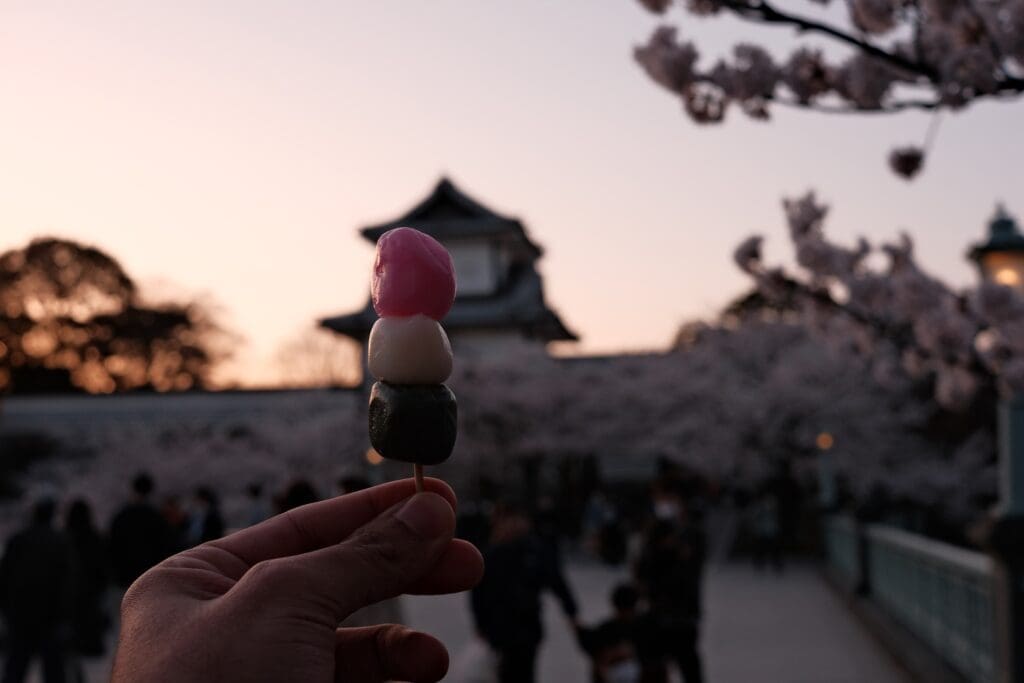
Buses
- Kanazawa Loop Bus: The easiest way to hop between key sights. It circles major stops like Omicho Market, Kenroku-en, Kanazawa Castle, the 21st Century Museum, and the geisha districts.
- Frequency: about every 15 minutes
- Hours: roughly 8:30 to 18:30
- Fare: about ¥210 per ride
- One-day passes exist and pay off if you’ll ride three or more times; pick one up at the station.
- How to ride: Board at the middle or rear door, exit at the front. Tap an IC card when you get off, or pay the driver in cash. Most major IC cards are accepted, but I still carry coins just in case. Stop announcements are in English at tourist-heavy points.
Taxis
Taxis are easy to find around the station, Kenroku-en, and major hotels. They’re perfect after dinner when buses thin out or when it’s pouring. I use the GO app in Japan, but hailing on the street works fine here.
Bikes
Kanazawa has a public bike share and a growing network of lanes. On a dry day, cycling between Omicho, Kenroku-en and the riverside teahouse districts is a joy. I wouldn’t choose bikes in winter or heavy rain; the streets can be slick from the snowmelt sprinklers.
Driving
You don’t need a car in the city, but renting one makes sense for the Noto Peninsula or a loop through the Kaga onsen towns. If you plan to drive in winter, check conditions and make sure your rental has snow-ready tires.
My simple strategy
- Morning: Walk to the first sight, beating the crowds.
- Midday: Use the Loop Bus for the longest hop.
- Late afternoon: Meander back on foot through a different street, or grab a taxi if your feet are done.
This keeps the day relaxed and lets you see Kanazawa’s smaller lanes, which is exactly where the city’s charm lives.
When to Visit Kanazawa
Short answer: spring and autumn are the sweet spots. But Kanazawa is a true four-season city, and each window changes how the city feels, what you’ll eat, and how much you’ll share it with others.
Here is how the year breaks down, with practical notes to help you choose.
Late March to May (spring)
- Why go: Kenroku-en erupts with plum and cherry blossoms, then fresh green. Peak sakura usually lands late March to early April.
- Weather: Cool to mild, generally comfortable for walking.
- Crowds and costs: Popular and pricier around blossom weeks and during Golden Week (late April to early May).
- Tips: Book stays and trains early if you want peak bloom. I recommend visiting Kenroku-en right at opening or late afternoon for calmer paths and softer light. Seasonal evening illuminations at the garden are worth planning around.
June to mid-July (rainy season)
- Why go: Fewer visitors, deep greens in the gardens, and the city feels quiet.
- Weather: Intermittent rain. Bring a light waterproof jacket and shoes that can handle puddles.
- Events: The Hyakumangoku Festival takes over the first weekend of June with a big parade, traditional performances, and a lively atmosphere.
- Tips: Keep a flexible plan and slot indoor stops like the 21st Century Museum or craft workshops between showers.
Late July to August (summer)
- Why go: Long days, festivals here and across Hokuriku, and photogenic riverside evenings in Kazue-machi.
- Weather: Hot and humid, often above 30°C. Expect afternoon showers.
- Crowds and costs: Busier around school holidays and Obon in mid-August.
- Tips: Sightsee early and late, break midday for a museum or a long lunch. I suggest booking restaurants since popular counters fill up fast this time of year.
September to late November (autumn)
- Why go: Clearer skies, comfortable temperatures, and some of the finest foliage anywhere. Kenroku-en and the castle parks usually peak around mid-November.
- Crowds and costs: Overall manageable until foliage peaks. Mid-November weekends get busy and rooms go fast.
- Tips: Aim for late October to early November if you want color without the gridlock. Evening illuminations during foliage season are gorgeous, and I’d plan one night around them.
December to February (winter)
- Weather: Cold and often wet or snowy. Daytime can hover around 8°C, with wind and sideways rain. Snow is common overnight.
- Crowds and costs: The quietest season, good availability and value.
- Tips: Pack waterproof shoes and a warm, windproof layer. The city runs snow-melting sprinklers along main streets, so walking stays feasible even after a dump of snow. Trains can be delayed in heavy weather, so avoid razor-thin connections. Kenroku-en’s yuki-tsuri ropes on the pines make winter photos special, and you might have entire corners of the garden to yourself.
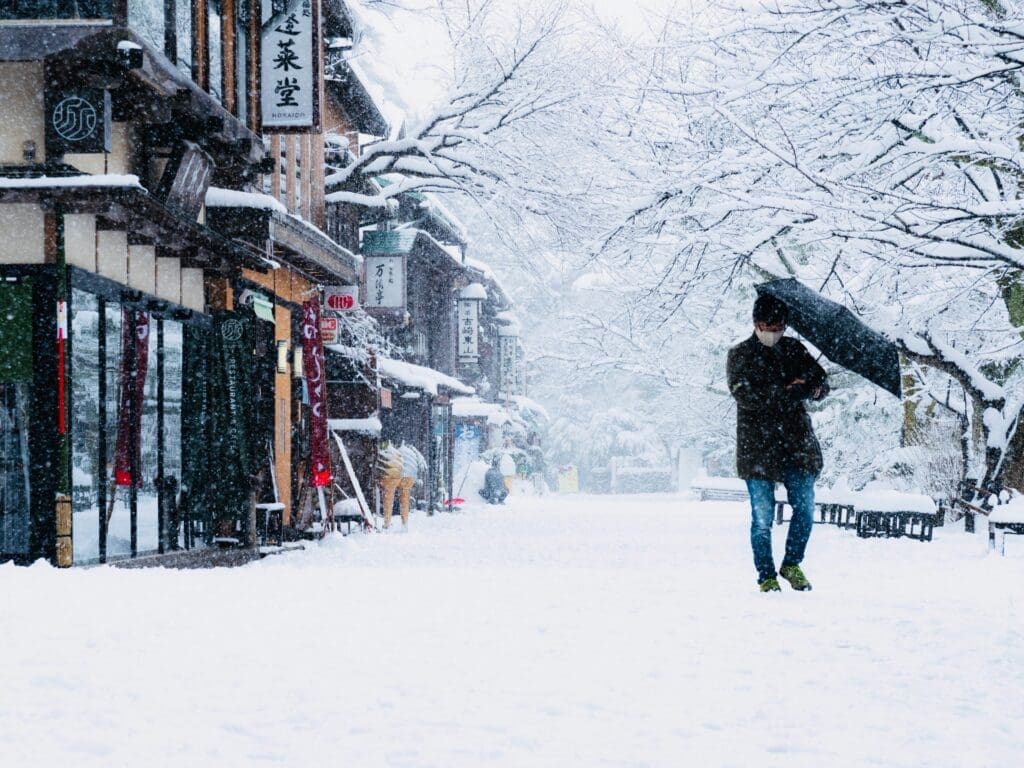
A few extra pointers:
- If you want the “best overall” balance, I suggest late October to early November or the week after peak cherry blossom. You get color and comfortable weather without the worst crowds.
- For crafts and museums, any season works. I like pairing a rainy afternoon with a gold leaf or Kutani workshop.
- Food-minded travelers should consider late autumn to winter for the seafood alone. I recommend planning at least one unhurried market morning in Ōmi-chō then a slow dinner at a sushi counter.
- Nightlife is mellow year-round. Evenings are for strolls in Higashi Chaya, seasonal garden lights, and an early seat at a cozy bar.
In short, choose spring for blossoms and buzz, autumn for foliage and crisp air, winter for quiet streets and incredible fish, and early summer if you want festivals with fewer tourists.
How Many Days to Spend in Kanazawa
Short answer: two full days is the sweet spot. The historic center is compact, sights are clustered, and you can cover a lot on foot. Three days lets you slow down for craft workshops or a geigi performance and still have time for long meals. If you want onsen or day trips, plan four to five days.
Here is how I recommend pacing it with full itineraries:
If you only have 1 day
- Morning: Be at Kenroku-en right when it opens, then cross to Kanazawa Castle. If the turrets are open, pop inside for the carpentry and views.
- Lunch: Ōmi-chō Market. Pick one or two stalls and stand to eat. I usually grab a seafood croquette and one sit-down bowl of kaisen-don.
- Afternoon: Wander Higashi Chaya. Step into Ochaya Shima to see a preserved teahouse and the instruments up close, then a gold leaf shop for a quick demo or treat.
- Evening: Stroll Kazue-machi along the Asano River. If seasonal night illuminations are on at Kenroku-en, go back for that. The city gets quiet by 9 pm, so dinner earlier is better.
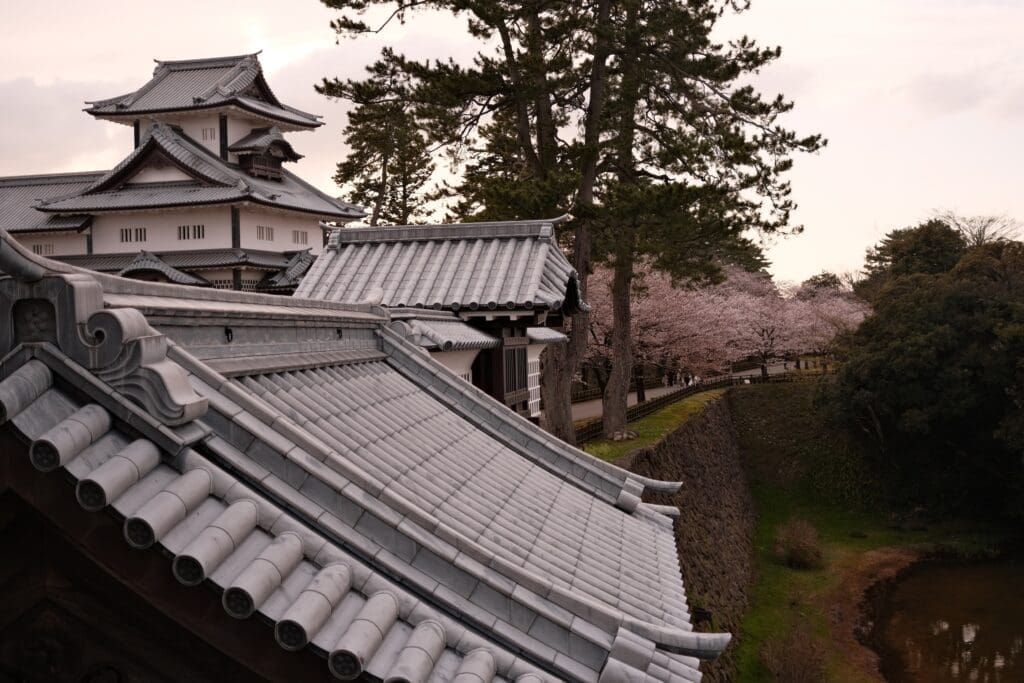
Two full days
- Day 1: Kenroku-en and the castle in the morning, Ōmi-chō for lunch, Higashi Chaya and Kazue-machi in the afternoon and early evening.
- Day 2: Nagamachi samurai district with Nomura-ke House, then pick one or two museums around the 21st Century Museum area. The D. T. Suzuki Museum is calm and easy to pair. End in Nishi Chaya for a short walk and a sento soak nearby if that’s your thing.
Three days
Keep the two-day plan and add:
- A hands-on craft session. Gold leaf application or Kutani-yaki painting are both beginner-friendly and memorable.
- Seisonkaku Villa beside Kenroku-en if you like historical interiors. It is one of the best preserved and feels surprisingly intimate.
- A geigi performance or cultural show if your dates align. With three nights you can be flexible, and I find evenings in the chaya districts are when Kanazawa really sinks in.
Food-wise, this is when I linger. I like an unhurried sushi counter at lunch one day and a longer dinner at a small local spot like Manmarumaru.
Four to five days or longer
- Add a night at a ryokan in the Kaga onsen area. Trains to Kagaonsen Station take about 45 minutes, and you can pick from villages like Yamashiro or Yamanaka. This is where breakfasts turn into an event.
- Slot in a day trip. Shirakawa-go is lovely in winter and easy by bus. Maruoka Castle in Fukui is a great original keep if you are into castles. In late spring, the Tateyama Kurobe Alpine Route is a full-day outing.
- Back in Kanazawa, go deeper on museums and workshops. The crafts and architecture scene here is stronger than most expect, and you will not run out of options.
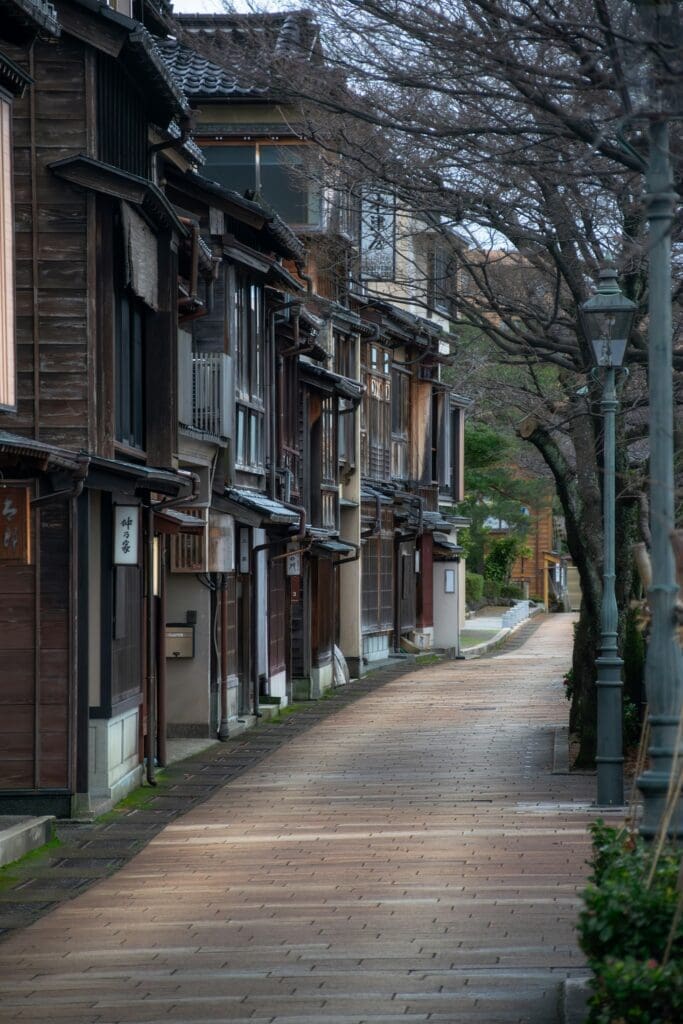
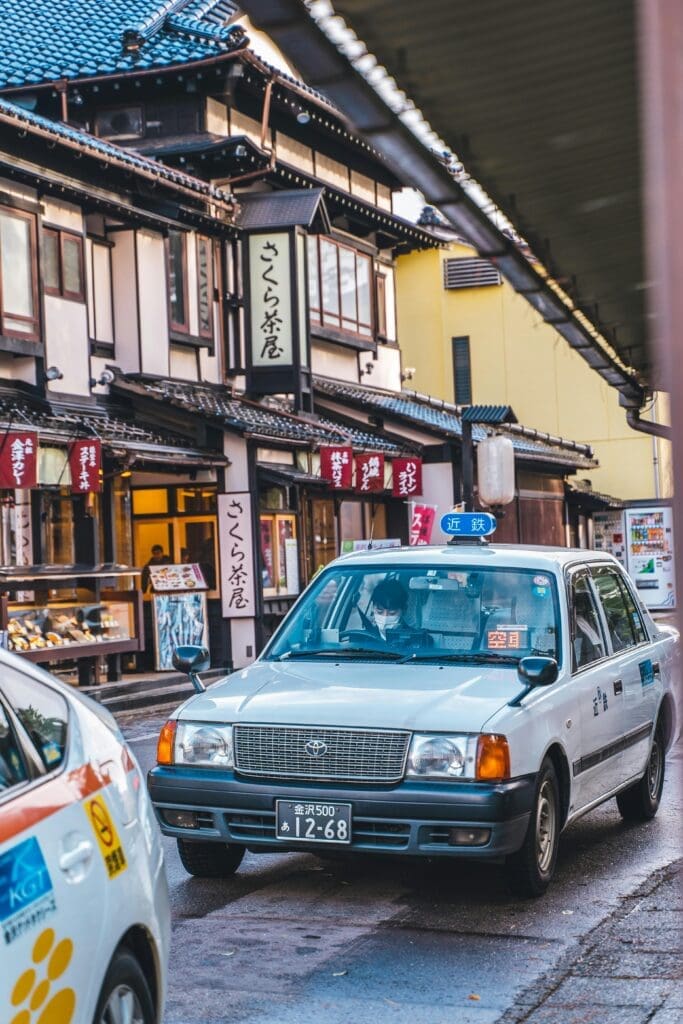
Should you do Kanazawa as a day trip?
- From Tokyo, it is technically doable if you leave very early on the Hokuriku Shinkansen, but it will feel rushed. I only suggest it if that is your only chance to visit.
- From Kyoto or Osaka, I do not recommend a day trip. Travel time is long and you will miss the best of the evening atmosphere. Stay at least one night.
Season and event notes
- Spring and autumn reward a slower pace. In late March to early April, plan extra time in Kenroku-en for blossoms. Mid-November foliage is fantastic, and the garden often has evening lights.
- Early June has the Hyakumangoku Festival. If your dates match, add a night for the parade and performances.
- Winter brings wind, rain, and snow, but the city stays walkable thanks to the street sprinklers. I keep a buffer in the schedule in case a train gets delayed and spend more time ducking into museums, teahouses, and warm lunches.
My bottom line: if you can, give Kanazawa two nights. Three is better if you care about crafts or performances. Four to five if you want to fold in an onsen stay or a proper day trip without rushing.
Top Things to Do in Kanazawa
Kanazawa’s sights sit close together, which makes planning simple. I like to group the day around the castle-and-garden core, then branch out to the geisha quarters by the Asano River, the samurai streets in Nagamachi, and Omicho Market for food. Leave space for a museum or a craft workshop. At night, the city is about atmosphere more than nightlife, so slow walks through the chaya districts or seasonal illuminations are the move.
Explore Kenroku-en Garden and Kanazawa Castle
Kenroku-en is the city’s headline act, and it earns that status year round. The Maeda clan shaped the garden over two centuries, so you get layered scenery rather than one postcard view. Stroll past Kasumigaike Pond, the famous stone lanterns, arched bridges, and a small waterfall, then pause at Japan’s oldest fountain quietly bubbling away. I recommend going early or late in the day when the light is soft and the group tours thin out.
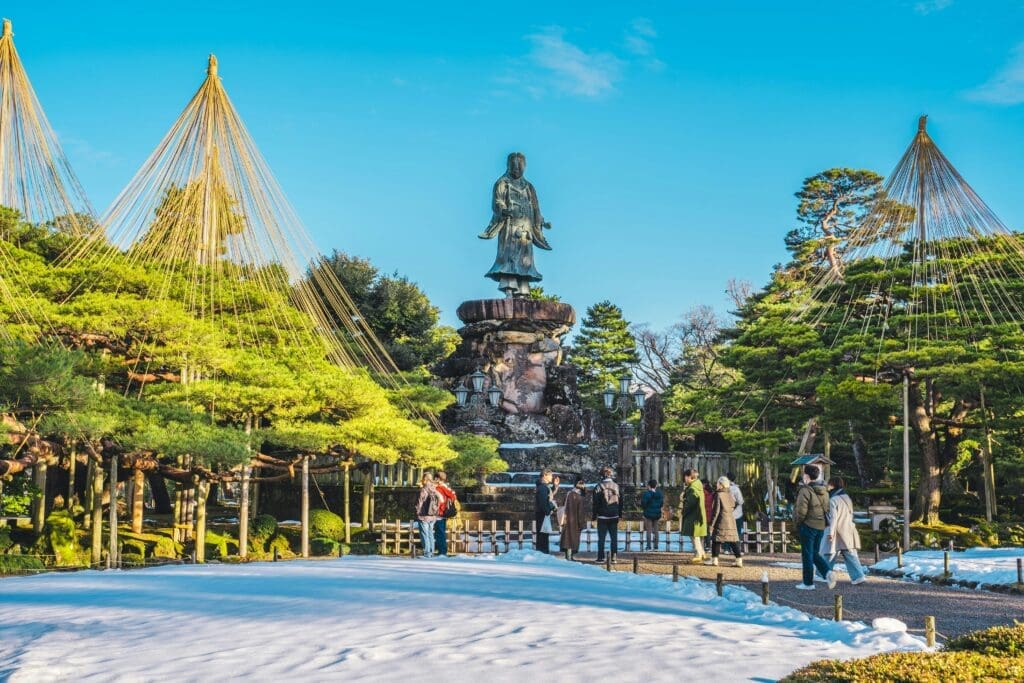
Seasonal tips:
- Winter: snow settles on the yukizuri ropes that protect the pines, and the whole garden feels muffled and calm. Some of my favorite visits have been in light snow.
- Late winter to early spring: the plum grove blooms first, then cherry trees pick up the show.
- Late spring: irises bring color to the water’s edge.
- Autumn: foliage usually peaks around mid-November, with vivid reds and golds across the maples and oaks.
Kenroku-en sits right across from Kanazawa Castle Park, so combine them. The original keep is gone, but several walls, gates, and turrets have been meticulously reconstructed, and the carpentry inside is worth a look. The castle grounds are free to walk; entering certain buildings requires a small fee. From March to December, volunteer guides are often on hand, and I’ve learned extra context from them that you simply do not get from the signs.
Practical notes:
- Both sites charge modest entry for certain areas, so keep a little cash handy.
- Watch for seasonal night illuminations at Kenroku-en. I plan my day to circle back after dinner if lights are on.
Walk the Geisha Districts
Kanazawa’s geisha quarters are beautifully preserved and each has a different feel. I suggest visiting one in the morning for quiet photos and again in the evening when lanterns switch on.
- Higashi Chaya: the most iconic, with wide stone streets and tall wooden teahouses. Pop into Ochaya Shima, a former teahouse that now displays hair ornaments, kimono items, and instruments used by geigi. Nearby, Hohsen-ji temple is tucked behind bamboo and makes a peaceful detour. This is also where you will run into gold leaf shops; if you are curious, try a gold leaf soft serve or a quick gilding demo.
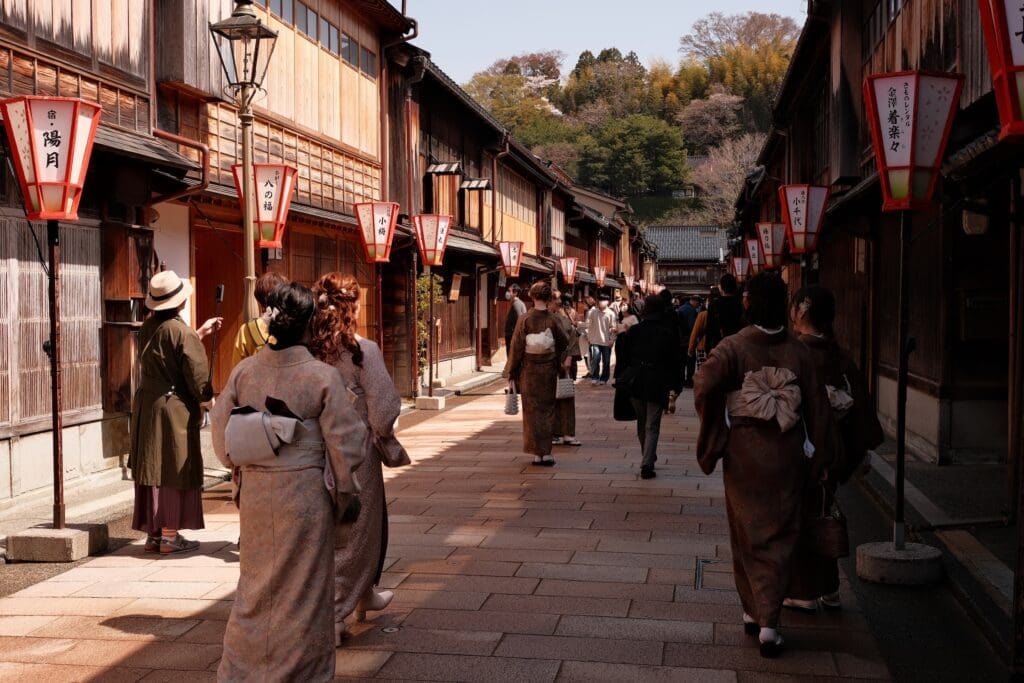
- Kazue-machi: a narrow strip along the Asano River, lined with willows. It is gorgeous under spring blossoms, in summer green, or during a snowfall. I like walking the river path here at dusk, then crossing back over to Higashi for dinner.
- Nishi Chaya: smaller and quieter, just south of the Sai River. It pairs well with a coffee break or a bathhouse stop nearby if you want to see a less-touristed side.
Public performances are occasional and tend to be seasonal or event based. If you are keen to catch geigi on stage, check schedules in advance, or ask at the tourism office when you arrive.
Visit Samurai Residences in Nagamachi
Nagamachi is a pocket of earthen walls, narrow lanes, and water channels that survived modern development. It feels lived-in, not staged, and you can cover it easily on foot.
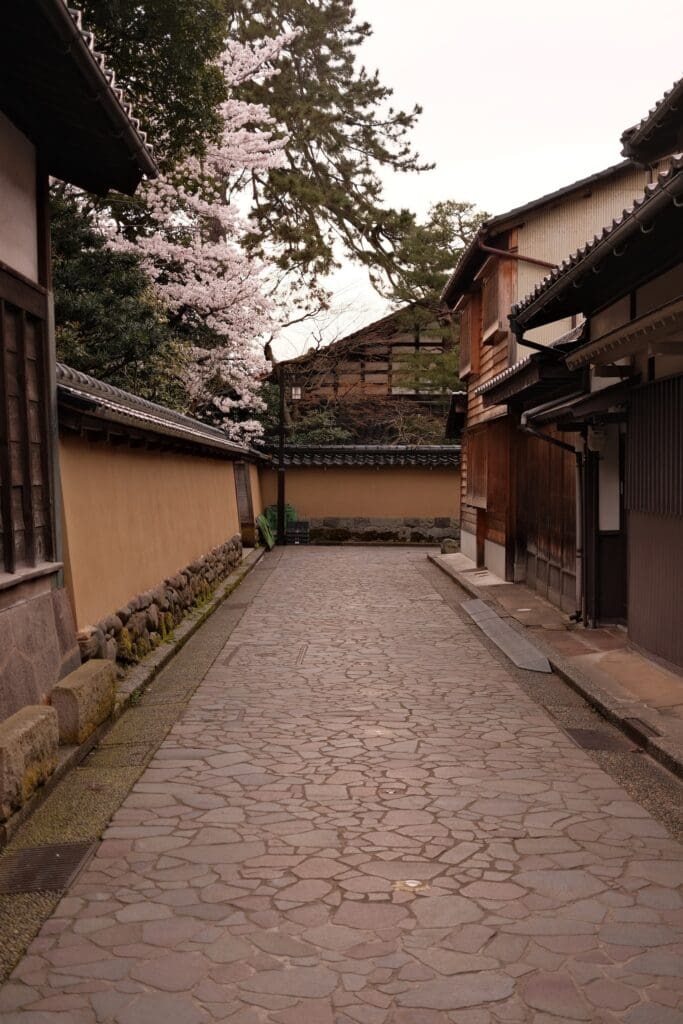
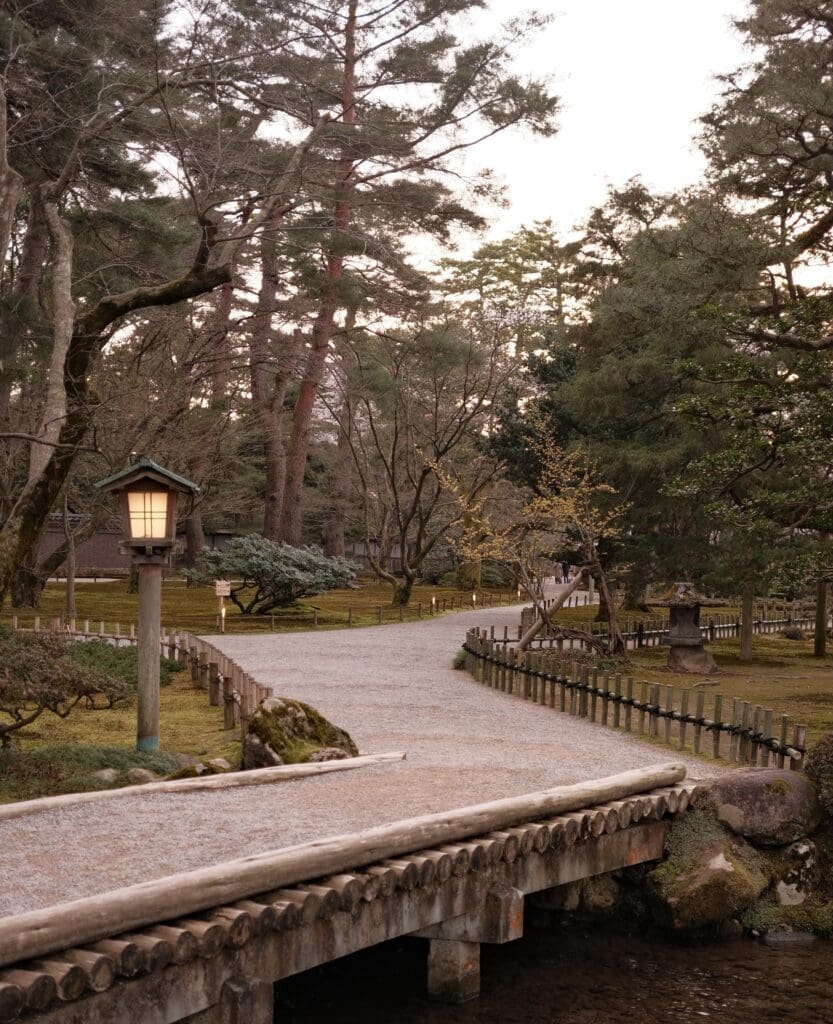
Nomura-ke House is the standout. Inside you will find elegant rooms, a compact but exquisite garden, and displays of samurai artifacts. The second-floor overlook onto the koi pond is one of those small, quiet Kanazawa moments that sticks with you. Nearby, smaller houses and museums fill out the picture of how mid-ranking samurai families lived.
Practical tips:
- Surfaces can be slick after rain or snow, so wear shoes with grip.
- If you are hungry after, Grill Otsuka is a local favorite for tonkatsu curry, which ties nicely into Kanazawa’s own curry style.
Enjoy Omicho Market
Ōmi-chō is the city’s seafood heart. It can feel pricey, but it is also where you can try seasonal specialties straight from the source. I go before lunch to beat the lines and graze as I go.
What to look for:
- Yellowtail/buri in winter, when the fish is fattest.
- Nodoguro (blackthroat seaperch), a local delicacy that is hard to find elsewhere.
- Crab croquettes, grilled anago on a stick, and simple bowls of ramen for quick fuel.
- Gold leaf treats if you are curious, including soft serve crowned in gold.
Market etiquette is simple: avoid eating while walking. Stand at the stall counter or in a designated area, finish, then move on. Many vendors accept cards now, but small coins speed things up for little bites.
If you want to see the industry side, JF Ishikawa runs tours with early-morning auctions, dock visits, and even a blast of the -30°F freezer. Book ahead, then follow it with a meal on the catch of the day at a partner restaurant.
Experience Art, Museums, and Local Crafts
Kanazawa’s art and craft scene is deep, and you can tune it to your interests.
- 21st Century Museum of Contemporary Art: a circular, glassy space with installations that reward slow wandering. Check which works are open, then give yourself time to sit and look.
- National Crafts Museum and the traditional crafts museum nearby: rotating exhibits of ceramics, lacquer, textiles, and metalwork that show why this region has such a strong craft reputation.
- D.T. Suzuki Museum: serene architecture, water courtyards, and concise exhibits on Zen and Suzuki’s life. I stop here when I need a quiet reset.
- Noh Museum, Phonograph Museum, Ohi Pottery Museum, and the Kanazawa Yasue Gold Leaf Museum: each is compact, focused, and easy to pair with other sightseeing.
Hands-on is where Kanazawa shines:
- Gold leaf workshops let you apply leaf to small boxes, chopsticks, or plates, then take your piece home. Hakuichi is a reliable place to start, and they also sell the famous gold leaf ice cream.
- Kutani-yaki ceramic painting is beginner friendly, and you get a very personal souvenir after firing.
- Other options include kaga yuzen dyeing, mizuhiki knot-tying, temari embroidery, and daruma painting. I recommend booking workshops ahead on weekends or holidays.
Small add-ons I love:
- The architecture around Kanazawa Station is worth a look, especially the huge wooden gateway.
- Myouryu-ji, often called the ninja temple, is a fun curveball if you like clever architecture. Tours are guided, so reserve in advance.
If you plan your day well, you can fit the garden and castle in the morning, a chaya district and Omicho Market at midday, then a museum or workshop in the afternoon. After dinner, loop back to the chaya streets or check for night illuminations at Kenroku-en. It is a relaxed rhythm that suits Kanazawa, and it leaves room for those small surprises that make the city memorable.
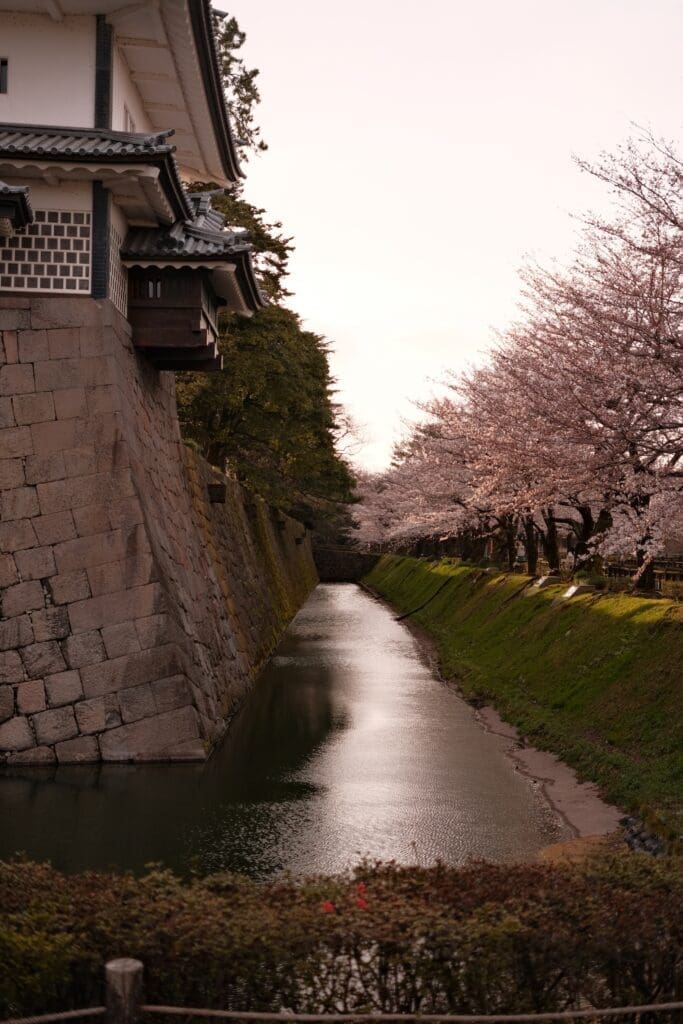
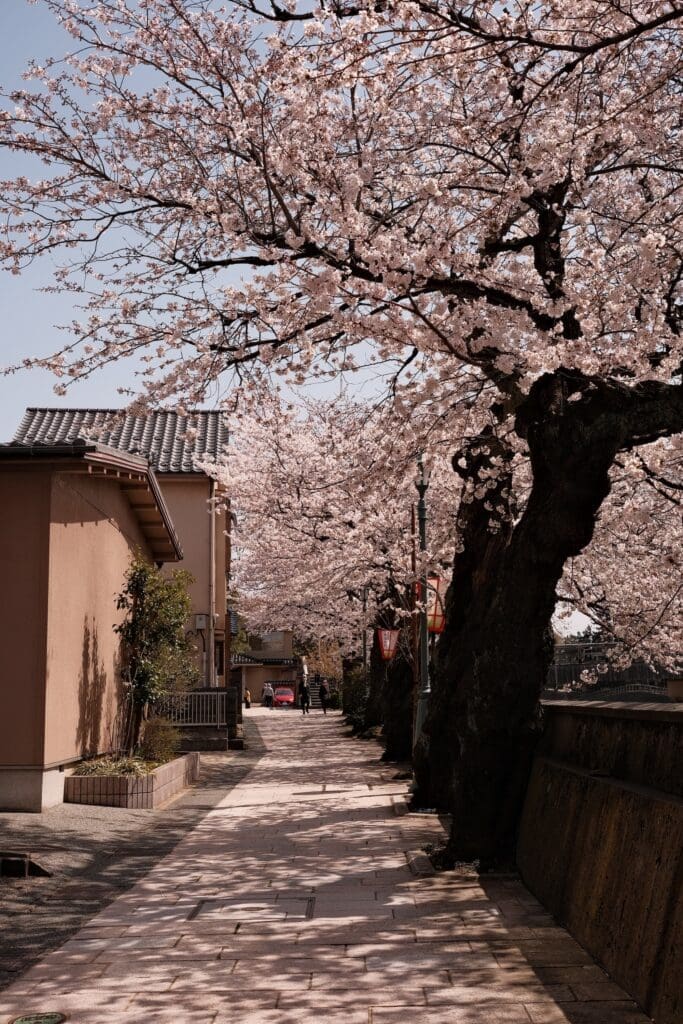
Food and Drink in Kanazawa
Kanazawa eats like a city twice its size. You get Sea of Japan seafood at its peak, elegant Kaga-style cooking rooted in the old Maeda domain, and a playful streak you feel in everything from curry to gold leaf desserts. I think Kanazawa is one of the best places in Japan to eat very well without draining your budget. Plan on seafood for at least one meal a day, then mix in a traditional dinner, a curry stop, and a slow coffee or matcha in the geisha districts.
Kanazawa’s Must-Try Dishes
- Sushi, sashimi, and kaisendon: The local catch is excellent. Look for nodoguro (blackthroat seaperch, often lightly torched), winter yellowtail buri, sweet shrimp, rock oysters in summer, and snow crab in season. A simple 10‑piece sashimi dinner can be as low as ¥1,400 to ¥3,000, which is great value here.
- Kanazawa oden: A comforting winter staple with delicate broth. If you see kani-men, a crab shell stuffed with crab meat and miso, order it.
Jibu-ni and Kaga ryori: Classic Kanazawa home cooking. Jibu-ni is duck or chicken stewed with wheat gluten in a thick soy-dashi. Kaga ryori highlights seasonal Kaga vegetables like lotus root and Kintoki carrot, prepared simply but beautifully.
Kanazawa curry: Dark, slightly sweet, with a rich roux that clings to shredded cabbage and rice. Add tonkatsu or ebi-fry on top. Chains like Go Go Curry, Champion’s Curry, and Turban are local staples.
Hanton rice: Local yoshoku comfort food. Think omurice topped with fried fish or shrimp and tartar sauce. It sounds heavy, it is, and it hits the spot after a long walking day.
Wagashi and matcha: Tea culture runs deep here. I recommend trying a seasonal namagashi with a bowl of matcha in or near the chaya districts.
Gold leaf treats: Kanazawa produces nearly all of Japan’s gold leaf. Try a soft serve crowned with gold leaf, or a gold-flaked drink for the novelty. It looks fancy, tastes the same, and is fun for a single photo.
Local sake: Ishikawa’s breweries turn out clean, expressive sake that pairs with seafood. A simple bottle at dinner often runs ¥550 to ¥1,200, so it’s easy to sample around.
Cafes, Markets, and Dining Spots
Ōmi-chō Market
- This is my breakfast and early lunch zone. Go before 11 am if you want calmer aisles and the best choice.
- Good bites to graze on include grilled anago on a stick, seafood croquettes, ramen, and kaisendon. Expect market-side snacks from about ¥250 to ¥1,000.
- Don’t walk and eat. Vendors appreciate it when you step to the side or use the small standing counters, finish, then move on.
- You will also find gold leaf soft cream here if you want the shiny cone.
Sushi and seafood meals
- I’ve had relaxed, memorable dinners at small counters like Okina Sushi, where a large sushi set with soup and sides was about ¥2,500. The mood feels local and the hospitality warm.
- For a late bite near the station, I often stop at Kirari, a kaiten conveyor-belt spot open until midnight. It’s easy and good between trains.
Curry and casual
- For a quick Kanazawa curry fix, pop into Go Go Curry, Turban, or Champion’s. If you’re around Nagamachi, Grill Otsuka is a solid sit-down option for tonkatsu curry after visiting the samurai houses.
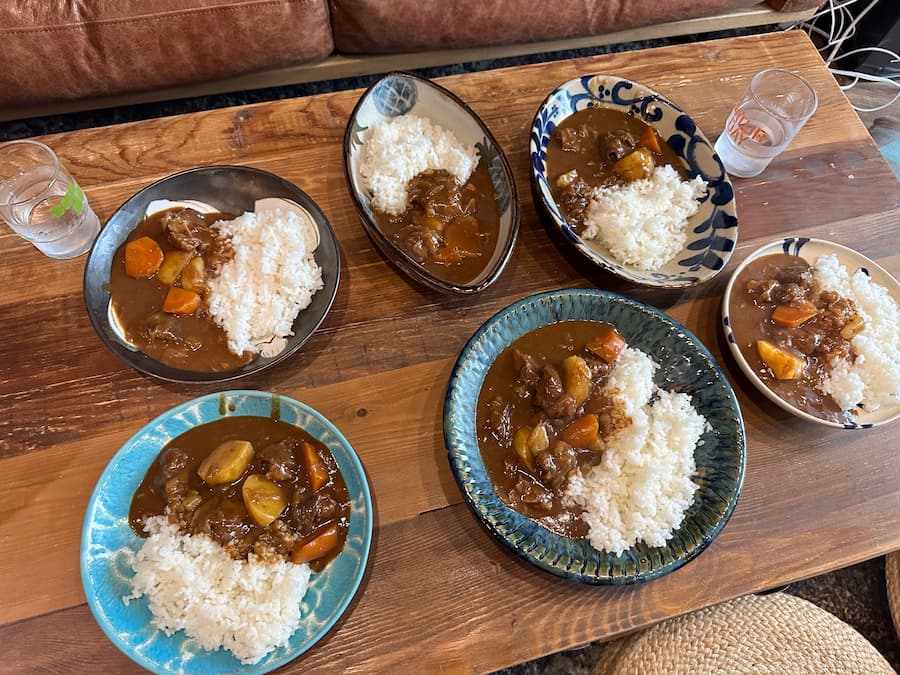
Tea, coffee, and sweets
- I like lingering in Higashi Chaya in the late afternoon with matcha and a small wagashi. The light on the lattice facades is beautiful then.
- For coffee, Curio Espresso and Vintage Design does proper lattes and even pulled-pork sandwiches. Cubby Hole is handy for breakfast wraps and matcha drinks. If you’re wandering near Nishi Chaya, a tiny espresso bar can turn into an unexpected hour of good conversation.
Creative dining and drinks
- Barrier is a conceptual spot with a set course that moves you from bright to dark spaces upstairs. It’s atmospheric and, in my experience, surprisingly affordable for the experience. Book if you can.
- If you drink, I’d budget one easy night around Katamachi and Korinbo, where most izakaya cluster, then end near Higashi Chaya. A cocktail at Furansu or a quiet whisky at Bar Gauche makes a great cap to an evening stroll.
- Inside Kanazawa Station, look for the Station Bar. I’ve seen people order sake ice cream and even gold leaf–topped drinks there, which is a very Kanazawa way to toast your trip.
Seafood industry peek
- If you want a food-nerd morning, you can join a local seafood tour that includes the early fish auction, dock visits, and even stepping into a minus 30 degree freezer. Some operators help you reserve a table afterward to eat the same day’s catch. Dress warm and book ahead.
Price cues
- Market snacks: roughly ¥250 to ¥1,000
- Affordable sashimi dinner: about ¥1,400 to ¥3,000
- A bottle of sake at dinner: about ¥550 to ¥1,200
Food Etiquette and Tips
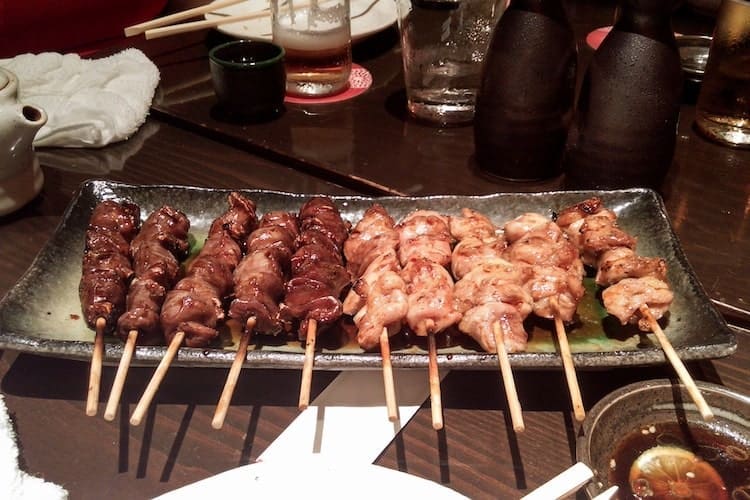
- Don’t eat while walking. In Kanazawa this is especially true at Ōmi-chō Market and in the chaya districts. I always stop at a corner or counter, eat, then continue.
- Book counters when you can. Small sushi shops fill fast. If you cannot reserve, arrive right when they open or late in the evening.
- Shoes off on tatami. If you step into a private room with tatami mats, remove shoes at the threshold.
- Sake etiquette is gentle here. It’s polite to pour for your companions first, receive with both hands, and pace yourself with small pours.
- Cash still helps. Cards and mobile payments are widely accepted, but I carry a few thousand yen for markets and tiny shops.
- Photos and lines. Ask before shooting vendors up close. Queueing is normal at popular stalls, and it moves quickly.
- Hours are early. Many restaurants take last orders around 8 to 8:30 pm and close by 9. I plan dinners on the earlier side and save strolling for after.
If you follow the seasons and keep meals simple, Kanazawa feeds you very well. I recommend starting each day with something from the market, leaving one night for a proper seafood dinner, and saving room for curry at least once. It is a good way to taste what this city does best.
Day Trips and Nearby Experiences
Kanazawa makes a relaxed base for the Hokuriku region. Fast trains reach Fukui and Toyama, and buses fan out to the mountains and UNESCO villages. You can soak in a hot spring by lunch and be back in the geisha districts by evening. Below are the day trips I recommend most, with how to get there and what to expect.
Kaga and Onsen Towns
About 45 minutes south of Kanazawa by train is the Kaga hot spring region. Take JR to Kagaonsen Station, then hop on local buses or short taxis to reach the four classic onsen towns: Yamanaka, Yamashiro, Katayamazu, and Awazu.
Yamanaka Onsen
- Why go: A forested gorge and a proper hot spring town feel. The Kakusenkei Gorge walk is an easy, scenic loop with red bridges and tea huts.
- Day trip idea: Soak at a public bathhouse, stroll the gorge, then browse small lacquerware shops before heading back.
Yamashiro Onsen
- Why go: Long history and Kutani ceramics. If you like hands-on, nearby craft villages offer quick workshops for painting ceramics or trying gold leaf.
Katayamazu Onsen
- Why go: Lakeside views and big-sky sunsets, with a modern glassy bathhouse facing the water.
Awazu Onsen
- Why go: Quiet and old-school. Good if you want fewer people and a slower pace.
If you can spare a night, I recommend staying in a ryokan here. Araya Totoan (Yamashiro) and Kayotei (Yamanaka) are standouts for refined service, in-house hot springs, and elaborate breakfasts. Dinner and breakfast are typically included and served at set times, so arrive by mid-afternoon if you’re staying overnight. On a day trip, use the public baths instead. Bring a small towel or rent one on-site, and note that tattoo policies vary.
Practical tips
- Getting around: From Kagaonsen Station, buses run regularly to each town; taxis are easy for short hops.
- Add a craft stop: The area is also a gateway to Komatsu’s historic lacquerware. I like pairing a soak with a quick visit to a workshop or showroom.
Other Notable Destinations
Shirakawa-go (UNESCO farm village)
- Travel time: About 75–90 minutes by highway bus from Kanazawa Station East Gate. Seat reservations are recommended.
- Why go: Iconic gassho-zukuri farmhouses and a mountain valley setting that looks unreal in winter snow and beautiful the rest of the year.
- Tip: For the postcard view, head up to the Ogimachi Castle viewpoint. It’s a 15–20 minute uphill walk, or you can take the local shuttle when it’s running. Paths can be icy in winter, so wear proper shoes. A day trip works well, but staying in a farmhouse is special if you can book ahead.
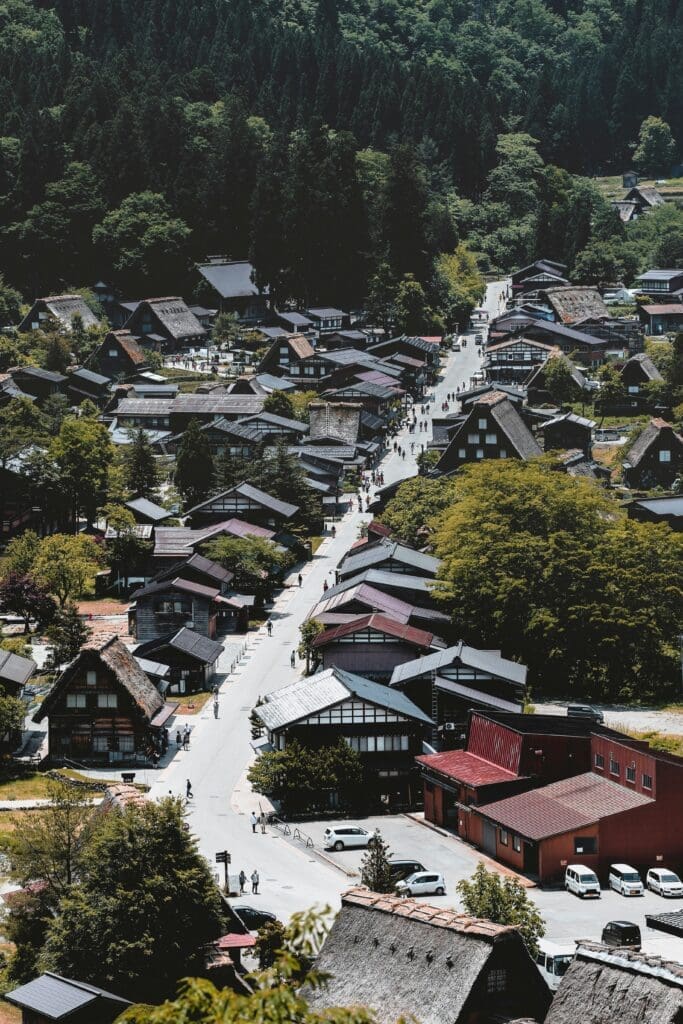
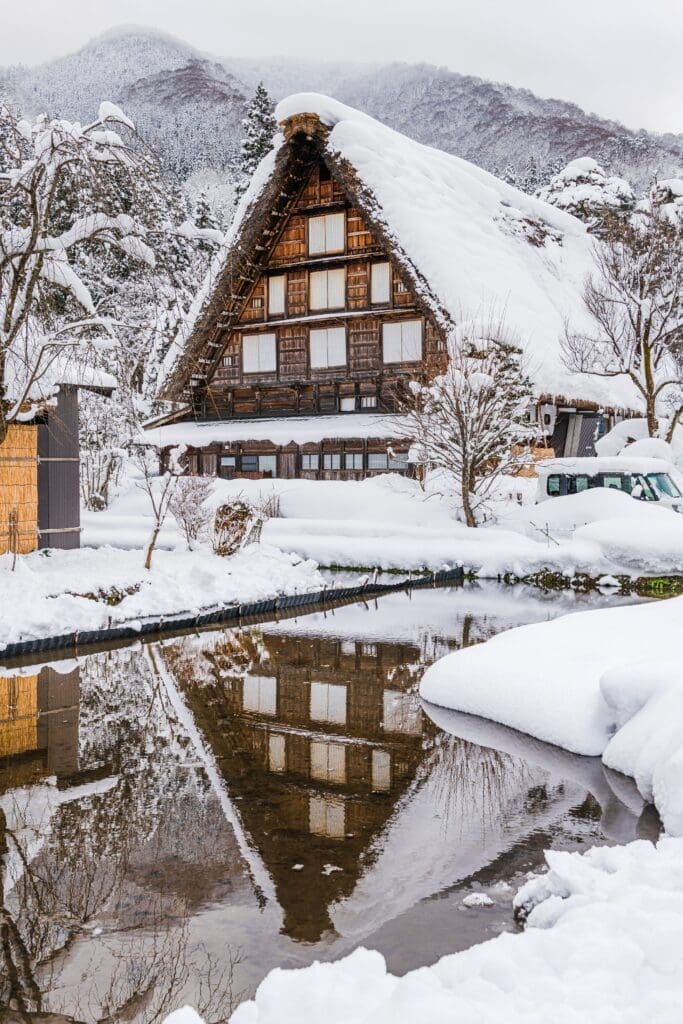
Tateyama Kurobe Alpine Route (snow walls and high alpine)
- Travel time: Shinkansen or conventional train to Toyama (around 25 minutes), then local railway to Tateyama Station and onward by cable car and buses. Plan a full day.
- Why go: The famed “snow wall” corridor usually opens after late April, and the high plateau around Murodo has surreal alpine views even when Kanazawa is warm.
- How to do it: For a day trip, I suggest going Toyama → Murodo → back the same way. The full traverse to Ogizawa is epic but long for a single day. Start early, bring layers, and check weather and ticket details in advance.
Maruoka Castle and Fukui
- Travel time: The Hokuriku Shinkansen now runs to Fukui, then it’s a short bus or taxi to Maruoka. Around 60–90 minutes total, depending on transfers.
- Why go: Maruoka Castle is one of Japan’s oldest surviving keeps, compact and atmospheric with steep stairs and town views.
- Combine with: If you have the energy, add a stop in Fukui city or pick one more site like Eiheiji Temple. Trying to do everything in one day is tough, so choose one or two.
Noto Peninsula (coastlines and small towns)
- Travel time: Best with a rental car from Kanazawa Station. Distances are larger than they look; consider an overnight if you want to circle the peninsula.
- Why go: Terraced paddies at Shiroyone Senmaida, fishing ports, and rugged Sea of Japan scenery. It’s a slower, very local slice of Ishikawa.
- Note: Conditions and access can change as the region continues recovery work. Check current road status and opening hours. If you do go, I recommend spending with small shops and family-run places.
Takayama (Hida’s preserved town)
- Travel time: About 2–2.5 hours by bus from Kanazawa. Possible as a long day, but better as an overnight.
- Why go: Edo-era streets, morning markets, and hearty Hida cuisine. I recommend checking my full Takayama guide.
- Tip: If you’re connecting via Shirakawa-go, avoid rushing both in one day. I’d either linger longer in Shirakawa-go or give Takayama a night.
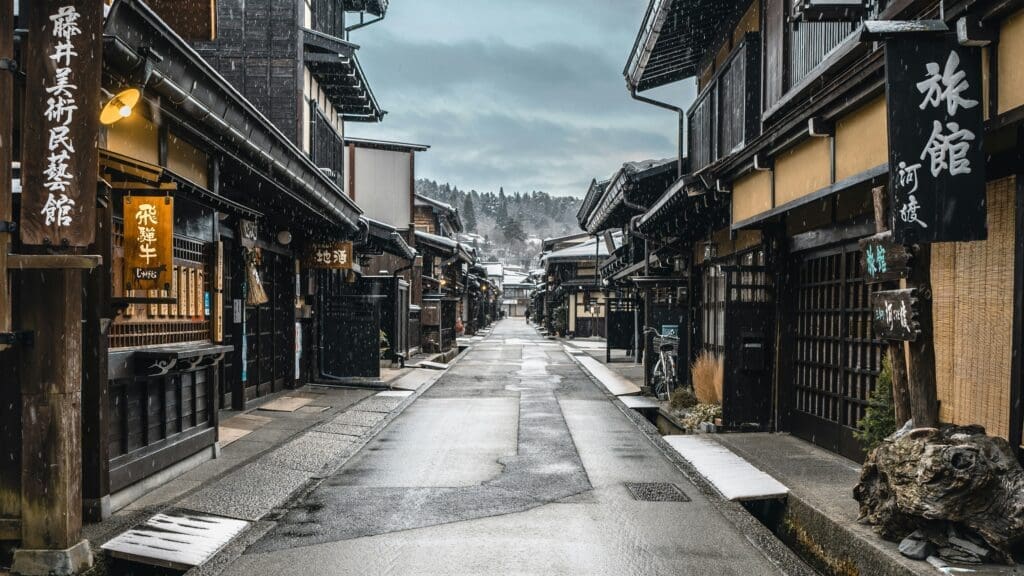
Why base in Kanazawa for these trips? The city’s pace makes early starts less painful, and you’re back in time for market snacks or a quiet evening walk through the tea districts. When I plan a Kanazawa trip, I like to pick one big day out and one light one, then leave the last day for the garden and castle. It keeps the travel days fun instead of frantic
Budgeting and Practical Tips
Kanazawa won’t drain your wallet like Tokyo or Kyoto can. Prices feel similar or a touch lower, and you can eat very well without spending much. The big costs are usually your hotel and the ride in. Once you’re here, the center is compact, buses are cheap, and many sights are either free or low-cost.
Typical Costs and Money Matters
Accommodation: plan roughly:
- Hostel beds: ¥5,400–7,200 per person
- Simple double in a business hotel: ¥13,450–19,500 per room
- Self-catering apartment: ¥18,000–24,000 per night
If you’re sharing rooms, your per-person cost drops. I’d book near Kanazawa Station or between the castle and Higashi Chaya to walk almost everywhere.
Food:
- At Omicho Market, small bites like croquettes or a stick of grilled seafood run about ¥250–1,000.
- A 10-piece sashimi set at a casual spot is often ¥1,400–3,000.
- A local sushi set dinner at a family-run counter can be around ¥2,500 and still feel generous.
- A bottle of sake at dinner is typically ¥550–1,200.
- Kanazawa curry is filling and affordable at the popular chains; it’s a good rainy-day lunch.
I like doing a light market breakfast, a bigger lunch, then an early dinner. Restaurants tend to close earlier here than in bigger cities.
Transport in town:
- The Kanazawa Loop Bus runs every ~15 minutes from around 8:30 to 18:30 and a single ride is about ¥210.
- Walking covers most of the central sights; taxis are easy to grab near the station if you’re tired or the weather turns.
If you’re doing several bus rides in a day, consider a day ticket, but only if you’ll actually use it a few times.
Card vs cash:
- Credit/debit cards and mobile payments are widely accepted at hotels, midrange restaurants, museums, and convenience stores.
- Carry some yen (I keep ¥3,000–¥5,000 in small coins/notes) for buses, mom-and-pop eateries, market stalls, and old-school bathhouses that are cash only.
- For cash withdrawals, 7-Eleven ATMs and Japan Post Bank ATMs are the most reliable for foreign cards.
I’ve never had trouble paying by card in the center, but cash speeds things up at Omicho and on buses.
What might cost more:
- Fresh seafood bowls at busy market restaurants can be pricier than you expect. If you’re on a budget, grab a couple of small bites at the market and save sushi for dinner off the main strip.
What’s free or low-cost:
- Castle park grounds are free to wander; entering certain turrets and exhibits has a small fee.
- Kenroku-en has a modest admission and is worth every yen. Seasonal night illuminations are often free or low-cost and a great value.

No tipping in Japan. If there’s a small service charge, it’s included on the bill. Just pay the total and thank the staff.
Useful Tips for Visitors
Getting around with ease:
- The Loop Bus is the simplest way to hop between sights. On most city buses you board through the rear door and pay when you exit at the front. Have small change ready; there’s usually a change machine by the driver.
- The city is flat and walkable. I suggest planning your days by area: Kenroku-en/Castle, then Higashi Chaya and the river; another day for Nagamachi and the museums.
Weather and clothing:
- Kanazawa sees frequent rain and in winter it can snow and blow sideways. I always pack a compact umbrella and waterproof shoes. If you visit in winter, treat icy stone paths with respect.
- You’ll notice the city’s snow-melting sprinklers on the roads; sidewalks still get wet. Waterproof or quick-dry layers make life easier.
Hours and pace:
- Many attractions close around 17:00–18:00, and a lot of restaurants wrap up by 21:00. I recommend eating dinner a bit earlier than you might in Tokyo. Nights are quiet; think evening strolls in Higashi Chaya rather than a big nightlife plan.
Language and help:
Market etiquette:
- Don’t eat while walking. At Omicho, eat next to the stall or in designated areas, then move on. Ask before photographing staff or food prep up close.
Onsen and sento basics:
- Some hotels have public baths. At public bathhouses, you bathe naked (no swimsuits), wash thoroughly before entering the tubs, and tattoos may or may not be an issue. Bring small cash. I’ve had good experiences at the older neighborhood bathhouses near Nishi Chaya.
Connectivity:
Luggage and lockers:
- Coin lockers at Kanazawa Station are plentiful, and luggage forwarding (takkyubin) to your next hotel is straightforward and often next-day. I like sending a suitcase ahead and traveling light for day trips.
Safety and common sense:
- Kanazawa feels very safe. Still, watch slick stones after rain, especially by the rivers and in gardens. In winter weather, give yourself a buffer in case trains or buses slow down.
Passes and routes:
- If you’re traveling Tokyo to Kansai via Kanazawa, regional rail passes can be good value. Schedules and routes change occasionally with new lines and seasonal adjustments, so I check them again a week before travel.
If you budget for a midrange hotel, a couple of taxis when the weather turns, and one or two seafood splurges, Kanazawa stays comfortable without getting expensive. Spend the savings on a craft workshop or a seasonal night illumination. Those are the memories you’ll keep.
The Bottom Line
What stands out about Kanazawa is how quickly it feels usable—a city where travelers don’t have to wrestle with crowds or logistics to enjoy the atmosphere, food, and neighborhoods that make it special. It’s easy to give yourself permission here to leave gaps in your schedule just for wandering or sitting in a quiet garden. If you treat Kanazawa as more than a stopover, you’ll find that the best moments are often unscripted: an empty side lane after dusk, a long lunch as the rain sweeps past, or a chat over coffee near a teahouse street. That’s the real value—Kanazawa gives you space to travel at your own pace and ends up sticking with you long after the trip.

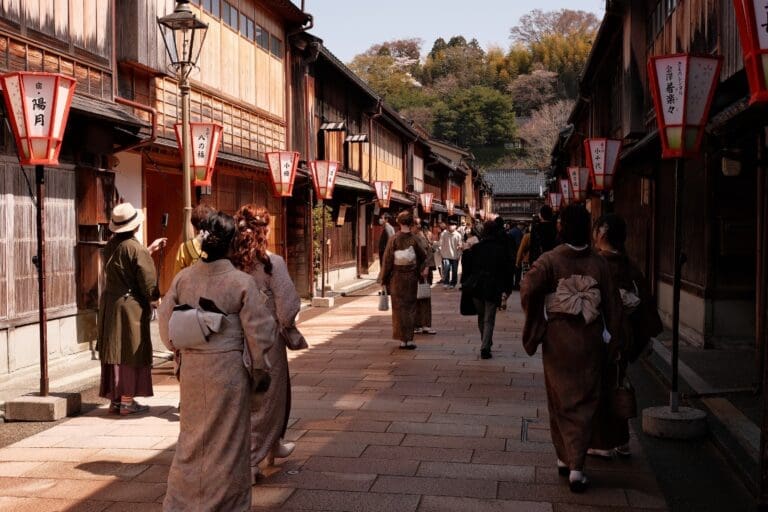
Comments are closed.